Introduction
The crisis caused by the COVID-19 pandemic, in addition to being a public health crisis has had an impact on the economy, the social activities, the way of interacting, the change in lifestyles due to lock-down, the closure of schools in a face-to-face mode, etc. All these facts are concerning, as there is the possibility that they may trigger problems of mental health that could escalate, even to suicide.
Emotion is a topic of study in psychology, philosophy, sociology, neuroscience, and more recently, artificial intelligence. Due to the topic is approached from multiple fields, its study is extensive, from emotional responses of facial expressions to different types of subjective experiences of an individual’s state of mind (Liu, 2012).
It is well known that human emotions are complex, and words often convey affect, that is, emotions, feelings, and attitudes. However, some relevant literature has shown studies about detection of emotions based on text analysis, Mohammad and Kiritchenko (2018) used Twitter for analyzing the intensity of emotions, considering supervised machine learning algorithms for multi- label emotion classification.
Using the social network Twitter (or Facebook) for getting textual data is convenient since tweets are self-contained, widely used, posts are available, and tend to be rich in emotions. It is also very common to use the statistical package R, through the NRC-Emotion Lexicon; it was created by crowdsourcing and includes entries for about 14,000 words and the eight basic Plutchik emotions (see Mohammad and Turney (2010), Mohammad and Turney (2013)).
Mohammad (2017) presented a manually created affect intensity lexicon (NRC Affect Intensity Lexicon, AIL) with real-valued scores of intensities for four basic emotions: anger, fear, joy, and sadness. However, it is common to study the basic emotions classified into positive (Joy and Confidence), negative (Sadness, Anger, Fear, and Aversion), and neutral (Surprise and Anticipation).
Experts say that basic emotions are usually presented in combination, that is, in a more complex form, and they rarely manifest alone. The combination of basic emotions is called dyad. Intensity or magnitude is a factor that distinguishes an emotion (or dyad) from another, it refers to the force with which an emotion is experienced. Primary dyads are those which people feel frequently, secondary dyads refer to those felt sometimes, and tertiary dyads to those rarely felt.
However, another important feature of an emotion, or a dyad, is the probability of having it. Using R and the NRC Emotion Lexicon, we can get the probability of having a basic emotion (called in this paper as prior probability), but until now, there is not a methodology to get the probability of having a dyad.
Plutchik (1989) has proposed a methodology of measuring emotions and their derivatives, but some interesting questions may arise:
- Having a prior distribution of some basic emotions, which are the probabilities and magnitudes of getting dyads of emotions?
- How can we classify profiles of people according to the probabilities and magnitudes of their dyads?
- Which dyads appear in profiles of people with emotions mainly positive, negative, and neutral?
Modelling emotions have become a very interesting area mainly for statisticians and psychologists. Using sentiment analysis, we can quantify the percentage of the emotions that people have, using the text they have written. Certainly, it is very common to use the social media platform Twitter (Rodríguez-Esparza, Barraza-Barraza, Salazar-Ibarra, and Vargas-Pasaye, 2019) in order to analyze the basic emotions (Joy, Confidence, Fear, Surprise, Sadness, Disgust/Aversion, Anger, and Anticipation- see Plutchik (1994)).
The succeeding parts of the paper are organized as follows. In Section 2, we provide some background on the field of emotions and sentiment analysis. Section 3 provides the methodology to calculate probabilities and magnitudes of getting dyads. In Section 4 we consider some profiles of people: positive, negative, neutral, and combined, in order to identify the mainly dyads presented in each profile. Finally, some conclusions are given in Section 5.
1. Background
The psychoevolutionary theory of emotions written by Plutchik (2001), postulates that emotions play an adaptive role in helping organisms to deal with key survival issues raised by the environment. For example, anger and fear are very primitive in human behavior and their function is to be prepared to pay attention (see Hochschild (1979), Plutchik (1994), Plutchik (2001)). Our emotions are also biologically linked with the senses, they help to understand our relationship with the senses of others and are essential for socialization (Hochschild, 1979).
Plutchik (2001) drew a wheel of emotions (see Figure 1), which consisted of eight basic emotions: 1. Joy, 2. Trust/confidence, 3. Fear, 4. Surprise, 5. Sadness, 6. Disgust/aversion, 7. Anger, and 8. Anticipation. Through the combination of them we get eight advanced emotions: love, submission, fright, disapproval, regret, contempt, aggressiveness, and optimism; these will be identified as Primary dyads (see Table 1). Moreover, basic emotions are combined with their neighbors, which will be named as Secondary and Tertiary dyads, which result in even less frequent emotions (see also Table 1). Also note that we can identify the opposite emotions, for example, the opposite of anticipation is surprise, the opposite of aversion is confidence, and so on.
Figure 1
Plutchik’s wheel of emotions.
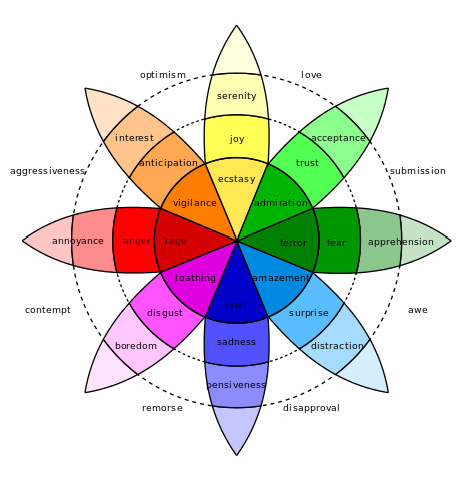
Source: From Plutchik (2001).
Table 1
Dyads of emotions given by Plutchik.
|
Primary dyads |
Secondary dyads |
Tertiary dyads |
|
Joy+Confidence=Love |
Joy+Fear=Guilt |
Joy+Surprise=Delight |
|
Confidence+Fear=Submission |
Confidence+Surprise=Curiosity |
Confidence+Sadness=Sentimentality |
|
Fear+Surprise=Fright (dismay) |
Fear+Sadness=Desperation |
Fear + Aversion=Embarrassment |
|
Surprise+Sadness=Disapproval |
Surprise+Aversion=Disbelief |
Surprise+Anger=Outrage |
|
Sadness+Aversion=Regret |
Sadness+ Anger=Envy |
Sadness+Anticipation=Pessimism |
|
Aversion+Anger=Contempt |
Aversion+Anticipation=Cynicism |
Aversion+Joy=Curiosity |
|
Anger Anticipation =Aggressiveness |
Anger+Joy=Pride |
Anger+Confidence=Domination |
|
Anticipation+Joy=Optimism |
Anticipation+Confidence=Fatalism |
Anticipation+Fear=Anxiety |
Source: From Plutchik (2001).
Emotions can be divided into positive, negative, and neutral. Positive emotions, like joy, increase physical, social, and intellectual human resources, and also build emotional reserves in the face of a challenge. Negative emotions, like fear, sadness, or anger, are natural defenses against external threats. Therefore, emotions govern human thought patterns, beliefs, behaviors, attitudes, and responses to life experiences (Ponce and Cordelier, 2019).
Until know, there is not a methodology to calculate the dyads. Therefore, the main purpose of this paper is to find the probability and magnitude of having combinations of basic emotions. One path of analyzing these measurements is through data mining. Hence, in the following section we introduce the technicalities of sentiment analysis.
1.1. Sentiment analysis
Sentiment analysis or opinion mining is an area of research that aims to the computational treatment of opinions, feelings, and subjectivity in texts; it arises as a way to identify the opinions and trends that people follow on social networks, blogs, or web pages (Raya-Ríos, 2017). The aim of sentiment analysis is diverse, it covers topics that go from opinions about products, movies or services, to social-cultural interest such as: elections, wars, or soccer, among others.
Bing Liu (2012) defines it as follows: “Sentiment analysis, also called opinion mining, is the field of study that analyzes people’s opinions, sentiments, evaluations, appraisals, attitudes, and emotions towards entities such as products, services, organizations, individuals, issues, events, topics, and their attributes”. According to the task in charge, we can find this analysis with different names: sentiment analysis, opinion mining, opinion extraction, sentiment mining, subjectivity analysis, affect analysis, emotion analysis, review mining, etc.
Messages on social media are usually short and lack of explicit sentiment words, therefore, Liu, Tang, Sun, Chen, Cao, Luo and Zhao (2020) proposed a model for performing context-aware user sentiment analysis, using a Twitter dataset. Dang, Moreno-García and De la Prieta (2020) employed deep learning to solve sentiment analysis problems, such as sentiment polarity, the authors also give a comparative study using different models and input features.
In the last decade, there have been interesting studies about sentiment and emotion analysis considering different fields of research. Barron-Estrada, Zatarain-Cabada and Bustillos (2019) presented a sentiment analyzer for the recognition of emotions centered on learning using textual phrases of students. Using tracking mode methods, Nahar, Sultana, Iqbal and Chowdhury (2019) used sentiment analysis to extract emotions from textual contents (micro-blogging).
Until now, most systems detect basic emotions and most research focusses on recognizing polarities of sentiments (positive and negative), however, it is important to also detect combinations of emotions. Therefore, in this work we present a methodology for this last purpose.
2. Methodology
In this section, we provide a novel methodology to calculate the probabilities and magnitudes of getting dyads.
2.1. Prior probability of the emotions
Once we obtain the text of the people, i.e., their tweets, we need to do a sentiment analysis using the library “syuzhet” of the statistical package R, and the function get nrc sentiment, to associate the words of the text with the eight primary emotions. Therefore, we can get the probability of each basic emotion $P_i, i \in \left\{ 1,\cdots ,8\right\}$, by normalizing this information, i.e., dividing the number of words obtained in the emotion $i$ by the total amount of words in all emotions.
2.2. Construction of dyads
To calculate the probabilities and the magnitudes of the dyads, we need to do the following. Let fix a basic emotion $i$, as before, using sentiment analysis we obtain $p_i$ (the prior probability of the emotion $i$, for $i \in \left\{ 1,\cdots ,8\right\}$).
Probability of the dyads
- Find the prior probabilities of the neighbors of emotion $i$.
Let $p_{ijk}$ be the prior probability of the $j$-th neighbor emotion of $i$, for $j \in \left\{1 ,2 ,3\right\}$, $j=1$ denotes the primary dyads, $j=2$ secondary dyads, and$j=3$ tertiary dyads, and considering the direction $k \in \left\{R,L\right\}$ here R means the neighbors’ emotions on the right of $i$, and L the neighbors’ emotions on the left side of $i$. See Figure 2.
Figure 2
Example of the construction of the dyads. If we consider $i=1$ i.e., Joy, then on a clockwise direction we construct the dyads: primary (Love), secondary (Guilt) and tertiary (Delight). Additionally, on a counterwise direction, we get the dyads: primary (Optimism), secondary (Pride) and tertiary (Curiosity).
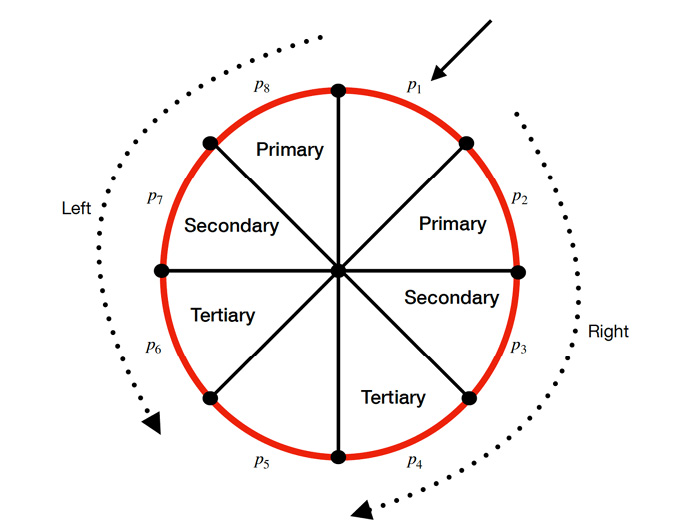
Source: Own elaboration
- Calculate the probability of the dyads.
We consider the basic emotion has the same probability (0.5) of going to its right ($k=R$) or going to its left ($k=L$). Fixing $k$(the direction), we can define: $$D_{i1k}=\mathrm{min}\left\{ p_1,p_{i1k}\right\}. \\ D_{i2k}=\mathrm{max}\left\{0,\mathrm{min}\left\{p_i-p_{i1k},p_{i2k} \right\} \right\}. \\ D_{i3k}= \mathrm{max}\left\{ 0,\mathrm{min}\left\{ p_1-p_{i1k}-p_{i2k},p_{i3k}\right\}\right\}.$$
Let$P_{ijk}$ denote the probability of the dyad $j$, $j \in \left\{ 1,2,3\right\}$ for $k \in \left\{ R,L\right\},associated with the emotion $i$. This probability is given by
|
$$ P_{ijk}=0.5D_{ijk}^{*}, $$ |
where $D_{ijk}^{*}=\frac{D_{ijk}}{\sum_{s=1}^{3}D_{isk}}, j\in \left\{ 1,2,3\right\}$, i.e.,$\sum_{j=1}^{3}D_{ijR}^{*}=1$ and $\sum_{j=1}^{3}D_{ijL}^{*}=1$. See the decision tree given in Figure 3. Note that $\sum_{j=1}^{3}\sum_{k\in\left\{R,L \right\}}P_{ijk}=1$ for all $i$.
Figure 3
Decision tree for calculating the probabilities of the dyads.
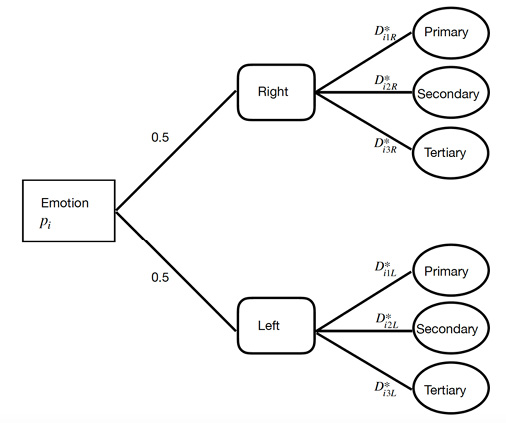
Source: Own elaboration.
Magnitude of the dyads
Once the probabilities of presenting dyads have been calculated, the most logical thing would be to calculate the magnitude with which they could occur. As an example, let us say that “aggressiveness” was obtained, but it could be present at a very low level, which would not be significant; conversely, at a high level, it would indicate that you must pay attention. This leads to the need to calculate its magnitude and not just limit itself to probability.
For $i\in \left\{1,2,\cdots ,8 \right\}$ and $k\in \left\{R,L \right\}$, as it was mentioned before, there is a probability of 0.5 of considering the right side of the emotions and 0.5 for the left, therefore we propose the weights of the dyads as follows: $W_{i1k}=0.30$ (primary dyads -frequently felt), $W_{i2k}=0.15$(secondary dyads -sometimes felt), and $W_{i3k}=0.05$ (tertiary dyads -rarely felt). These weights are arbitrary, but with the assumption that all weights must sum up to 0.5.
The magnitude of the dyads for $i\in\left\{ 1,2,\cdots ,8\right\},j\in\left\{ 1,2,3\right\},k\in\left\{ R,L\right\}$ is given by
|
$$ M_{ijk}=\frac{D_{ijk}^{*}W_{ijk}}{\sum _{s}D_{ijs}^{*}W_{ijs}}. $$ |
Satisfying $\sum_{j=1}^{3}\sum _{k\in\left\{R,L \right\}}M_{ijk}=1$ for all $i$.
Note that if a probability $P_{ijk}$ is 0 then the magnitude $M_{ijk}$ is also 0.
2.3. Classification
Classification is a widely used statistical tool to characterize objects or people by groups. The elements within the same group (cluster) share similar characteristics, while their features are different between groups. In opinion mining, classification is also very important, since it will be possible to identify profiles of people who have high probability and magnitude in such a way that they influence the analysis.
In order to classify the probability and magnitude of the dyads, we have proposed to divide them into six groups (see Table 2).
Table 2
Classification for the probability and magnitude of dyads.
|
Interval |
Classification |
|
[0.0, 0.2) |
Lowest |
|
[0.2, 0.3) |
Low |
|
[0.3, 0.5) |
Medium |
|
[0.5, 0.7) |
High |
|
[0.7, 0.8) |
Very High |
|
[0.8, 1.0] |
Max |
Source: Own elaboration.
We will say that dyads with levels Max, Very High, and High probability and magnitude have more impact on the decision of the profiles, and dyads with levels Medium, Low, and Lowest have less impact on the decision of the profiles.
Figure 4 shows a way of reading the results of the probabilities and magnitudes of the dyads according to their classification. For example, “With High probability and Medium magnitude, I feel Optimism”. The probability and magnitude are quantitative data, while the dyad is a qualitative data.
Figure 4
Reading the results of the probabilities and magnitudes of the dyads.
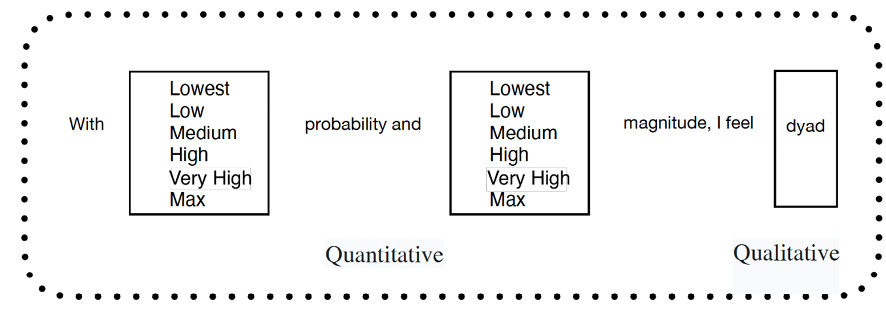
Source: Own elaboration.
3. Results
Let consider three types of people profile: the first one, having major probability of the positive basic emotions -called Positive profile-, the second, having more probability of the negative basic emotions -called Negative profile-, and the third one, having more probability of the neutral basic emotions -called Neutral profile- (see Figure 5).
Figure 5
Example of Positive, Negative, and Neutral profiles.

Source: Own elaboration.
Table 3 exhibits the results of the probabilities and magnitudes (including their classification) of the obtained dyads considering the Positive profile. Throughout the paper, the results of dyads having probability and magnitude equals to 0 are omitted.
Table 3
Results of the Positive profile.
|
Basic Emotion |
$p_i$ |
Dyad |
Emotion |
Pro-babi-lity |
Magni-tude |
Classifica-tion Probability |
Classifica-tion Magnitude |
|
Joy |
0.35 |
Primary |
Love |
0.7 |
0.875 |
Very High |
Max |
|
Joy |
0.35 |
Primary |
Optimism |
0.1 |
0.075 |
Lowest |
Lowest |
|
Joy |
0.35 |
Secondary |
Pride |
0.1 |
0.0375 |
Lowest |
Lowest |
|
Joy |
0.35 |
Tertiary |
Curiosity |
0.1 |
0.0125 |
Lowest |
Lowest |
|
Confidence |
0.35 |
Primary |
Submission |
0.1 |
0.075 |
Lowest |
Lowest |
|
Confidence |
0.35 |
Primary |
Love |
0.7 |
0.875 |
Very High |
Max |
|
Confidence |
0.35 |
Secondary |
Curiosity |
0.1 |
0.0375 |
Lowest |
Lowest |
|
Confidence |
0.35 |
Tertiary |
Sentimentality |
0.1 |
0.0125 |
Lowest |
Lowest |
Source: Own elaboration.
For this Positive profile, Love is surely a dyad that has high probability and magnitude. Optimism and Submission are dyads that can appear with medium probability and magnitude. Other dyads that can appear, but with low probability and magnitude, are Pride, Curiosity, and Sentimentality.
Table 4 shows the results of the probabilities and magnitudes (including their classification) of the obtained dyads considering the Negative profile.
Table 4
Results of the Negative profile.
|
Basic Emotion |
$p_i$ |
Dyad |
Emotion |
Pro-babi-lity |
Magni-tude |
Classifica-tion Probability |
Classifica-tion Magnitude |
|
Fear |
0.2 |
Primary |
Fright |
0.1429 |
0.2692 |
Lowest |
Low |
|
Fear |
0.2 |
Primary |
Submission |
0.1429 |
0.2308 |
Lowest |
Low |
|
Fear |
0.2 |
Secondary |
Desperation |
0.4286 |
0.3462 |
Medium |
Medium |
|
Fear |
0.2 |
Secondary |
Guilt |
0.1429 |
0.1154 |
Lowest |
Lowest |
|
Fear |
0.2 |
Tertiary |
Anxiety |
0.1429 |
0.0385 |
Lowest |
Lowest |
|
Sadness |
0.2 |
Primary |
Regret |
0.5 |
0.7143 |
High |
Very High |
|
Sadness |
0.2 |
Primary |
Disapproval |
0.125 |
0.125 |
Lowest |
Lowest |
|
Sadness |
0.2 |
Secondary |
Desperation |
0.375 |
0.1607 |
Medium |
Lowest |
|
Aversion |
0.2 |
Primary |
Contempt |
0.5 |
0.5 |
High |
High |
|
Aversion |
0.2 |
Primary |
Regret |
0.5 |
0.5 |
High |
High |
|
Anger |
0.2 |
Primary |
Aggressiveness |
0.1429 |
0.12 |
Lowest |
Lowest |
|
Anger |
0.2 |
Primary |
Contempt |
0.5714 |
0.8 |
High |
Max |
|
Anger |
0.2 |
Secondary |
Pride |
0.1429 |
0.06 |
Lowest |
Lowest |
|
Anger |
0.2 |
Tertiary |
Domination |
0.1429 |
0.02 |
Lowest |
Lowest |
Source: Own elaboration.
For this Negative profile, Contempt and Regret are surely dyads that have high probability and magnitude. Desperation is a dyad with medium probability and magnitude. Other dyads that can appear, but with low probability and magnitude, are: Fright, Sub- mission, Guilt, Anxiety, Disapproval, Aggressiveness, Pride, and Domination.
Table 5 has the results of the probabilities and magnitudes (including their classification) of the obtained dyads considering the Neutral profile.
Table 5
Results of the Neutral profile.
|
Basic Emotion |
$p_i$ |
Dyad |
Emotion |
Pro-babi-lity |
Magnitude |
Classifica-tion Probability |
Classifica-tion Magnitude |
|
Surprise |
0.35 |
Primary |
Disapproval |
0.1667 |
0.3 |
Lowest |
Medium |
|
Surprise |
0.35 |
Primary |
Fright |
0.1667 |
0.3 |
Lowest |
Medium |
|
Surprise |
0.35 |
Secondary |
Disbelief |
0.1667 |
0.15 |
Lowest |
Lowest |
|
Surprise |
0.35 |
Secondary |
Curiosity |
0.1667 |
0.15 |
Lowest |
Lowest |
|
Surprise |
0.35 |
Tertiary |
Outrage |
0.1667 |
0.05 |
Lowest |
Lowest |
|
Surprise |
0.35 |
Tertiary |
Delight |
0.1667 |
0.05 |
Lowest |
Lowest |
|
Anticipation |
0.35 |
Primary |
Optimism |
0.1667 |
0.3 |
Lowest |
Medium |
|
Anticipation |
0.35 |
Primary |
Aggressive-ness |
0.1667 |
0.3 |
Lowest |
Medium |
|
Anticipation |
0.35 |
Secondary |
Fatalism |
0.1667 |
0.15 |
Lowest |
Lowest |
|
Anticipation |
0.35 |
Secondary |
Cynicism |
0.1667 |
0.15 |
Lowest |
Lowest |
|
Anticipation |
0.35 |
Tertiary |
Anxiety |
0.1667 |
0.05 |
Lowest |
Lowest |
|
Anticipation |
0.35 |
Tertiary |
Pessimism |
0.1667 |
0.05 |
Lowest |
Lowest |
Source: Own elaboration.
For the Neutral profile we identify that the dyads: Disbelief, Curiosity, Fatalism, Cynicism, Outrage, Optimism, Anxiety, and Pessimism have both Lowest probability and magnitude, except for Disapproval, Fright, Optimism, and Aggressiveness that have Medium magnitude.
3.1. Combined profile
As another example, let consider a random person from Twitter called in this work as Combined profile, where his/her last 1000 tweets have been analyzed, and the language used was Spanish. Figure 6 shows the analysis of his/her tweets in groups of one hundred at a time. For each group of data, we obtained the prior probability of each basic emotion.
Prediction is a widely used resource in modeling and specifically in opinion analysis to identify the behavior of a phenomena or, in this case, emotions of people, in the future. For example, in terms of sales, it is important to know the emotional state of customers to release a product to the market.
Since the sum of all the prior probabilities is 1, we can consider the vector $\left ( p_i,p_2,\cdots ,p_8 \right )$, as a compositional vector. Therefore, we can predict his/her next prior probabilities via a compositional analysis. Using a hyperspherical transformation (we recommend Wang, Lu, Mok, Fu and Tse (2007) to see the details of this transformation), we predicted his/her 500 next tweets -denoted in Figure 6 by P1, P2, . . . , P5- in order to see the behavior (emotions) of this profile in the future.
Figure 6
Combined profile: 1000 tweets, in groups of one hundred at a time. Prediction using compositional data.

Source: Own elaboration.
Figure 6 shows that, mainly, his/her Confidence and Sadness are getting low, while his/her Anger is increasing (see Figure 7). The other basic emotions remain almost with the same prior probabilities.
Figure 7
Prior probabilities of the basic emotions of Combined profile obtained from the prediction P5.
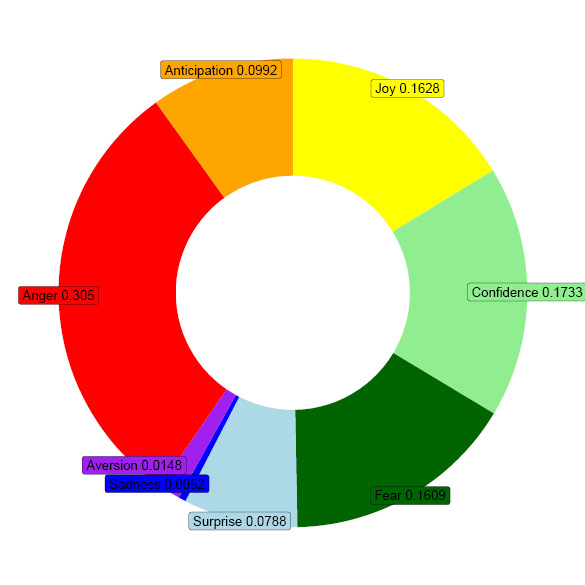
Source: Own elaboration.
Sadness and Aversion are the emotions with the lowest prior probability. These emotions are classified as negative. Also note that these emotions are neighbors, with opposite emotions Joy and Confidence, respectively. Then, he/she has Surprise and Anticipation. This is quite interesting since both are opposites and are considered as neutral emotions. Surprise is considered by some theorists to be one of the emotions that have a universal pattern of facial expression. The physiological response includes raising or arching the eyebrows, opening the eyes wide, opening the mouth wide in an oval shape, and gasping. Fear, Joy, and Confidence have almost the same prior probability. These emotions are neighbors. The dyads from these emotions are expected to have high probability. And finally, Anger is the basic emotion with the highest prior probability. Remember that is a negative emotion.
In Table 6 we present the resulting dyads of the Combined profile.
Table 6
Results of the dyads of the Combined profile.
|
Basic Emotion |
$p_i$ |
Dyad |
Emotion |
Pro-babi-lity |
Magni-tude |
Classifica-tion Probability |
Classifica-tion Magnitude |
|
Fear |
0.1609 |
Primary |
Fright |
0.3034 |
0.2238 |
Medium |
Low |
|
Fear |
0.1609 |
Primary |
Submission |
0.6196 |
0.7618 |
High |
Very High |
|
Fear |
0.1609 |
Secondary |
Desperation |
0.02 |
0.0074 |
Lowest |
Lowest |
|
Fear |
0.1609 |
Tertiary |
Embarrass-ment |
0.057 |
0.007 |
Lowest |
Lowest |
|
Joy |
0.1628 |
Primary |
Love |
0.5 |
0.6478 |
Medium |
High |
|
Joy |
0.1628 |
Primary |
Optimism |
0.3047 |
0.2763 |
Medium |
Low |
|
Joy |
0.1628 |
Secondary |
Pride |
0.1953 |
0.0759 |
Lowest |
Lowest |
|
Confidence |
0.1733 |
Primary |
Submission |
0.4642 |
0.4824 |
Medium |
Medium |
|
Confidence |
0.1733 |
Primary |
Love |
0.4697 |
0.4881 |
Medium |
Medium |
|
Confidence |
0.1733 |
Secondary |
Curiosity |
0.0358 |
0.0159 |
Lowest |
Lowest |
|
Confidence |
0.1733 |
Secondary |
Fatalism |
0.0303 |
0.0135 |
Lowest |
Lowest |
|
Anger |
0.305 |
Primary |
Aggressive-ness |
0.2457 |
0.4544 |
Low |
Medium |
|
Anger |
0.305 |
Primary |
Contempt |
0.0367 |
0.0678 |
Lowest |
Lowest |
|
Anger |
0.305 |
Secondary |
Pride |
0.4032 |
0.3729 |
Medium |
Medium |
|
Anger |
0.305 |
Secondary |
Envy |
0.0129 |
0.0119 |
Lowest |
Lowest |
|
Anger |
0.305 |
Tertiary |
Domination |
0.1065 |
0.0328 |
Lowest |
Lowest |
|
Anger |
0.305 |
Tertiary |
Outrage |
0.1951 |
0.0602 |
Lowest |
Lowest |
Source: Own elaboration.
In ordering Table 6 according to the variable Probability, we can see that Submission (Confidence+Fear) is in the first place. Submission means compliance with or surrender to the requests, demands, or will of others. Note that if we have a prior probability of fear 0.1609, then we will have Submission with a probability 0.6196 and magnitude 0.7618, On the other hand, if we have a prior probability of Confidence of 0.1733, then we will have Submission with probability 0.4697 and magnitude 0.4824.
The second place dyad is Love (Joy+Confidence). Love is an emotion that involves feelings of affection for the object of love, including pleasurable sensations of it. Pride (Anger+Joy) is a self-conscious emotion that occurs when a goal has been attained and one’s achievement has been recognized and approved by others. Having Anger with a prior probability 0.3050, will lead to having Pride with probability 0.4032 and magnitude 0.3729. However, having Joy with prior probability 0.1628, will lead to having Pride with probability 0.1953 and magnitude 0.0759.
Then we have Optimism (Anticipation+Joy), which is the attitude that good things will happen, and that people’s wishes will ultimately be fulfilled. Fright (Fear+Surprise) is the emotional reaction that arises in the face of a dangerous or potentially dangerous situation or encounter. Having the emotion Fear with a prior probability of 0.1609 will lead to having Fright with probability 0.3034 and magnitude 0.2238.
Aggressiveness (Anger+Anticipation) is a tendency toward social dominance, threatening behavior, and hostility. It may occur sporadically or be a characteristic trait of an individual.
From Table 6 we can say that the Combined profile has:
- With High probability and Very High magnitude, he/she is feeling Submission.
- With High probability and High magnitude, he/she is feeling Love.
- With Medium probability and Medium magnitude, he/she is feeling Submission, Love, and Pride.
- With Medium probability and Low magnitude, he/she is feeling Fright, and Optimism.
- With Low probability and Medium magnitude, he/she is feeling Aggressiveness.
- With Lowest probability and Lowest magnitude, he/she is feeling Desperation, Embarrassment, Pride, Curiosity, Fatalism, Domination, Contempt, Envy, and Outrage.
A very important point here is the following. Note that Anger has a very high prior probability, but its neighbors have very low prior probabilities, this means that Aggressiveness and Contempt (primary dyads) do not have high probabilities.
A summary of different profiles are presented in Table 7.
Table 7
Dyads of positive, negative, neutral, and combined profiles.
|
Profile |
Max/Very High |
High/Medium |
Low/Lowest |
|
Positive |
Love |
Optimism, Submission |
Pride, Curiosity, Sentimentality |
|
Negative |
Contempt and Regret |
Desperation, Fright, Submission, Disapproval, Aggressiveness |
Guilt, Anxiety, Pride, and Domination |
|
Neutral |
Fright, Disapproval, Aggressiveness, Optimism |
Cynicism, Outrage, Optimism, Anxiety, and Pessimism |
|
|
Combined |
Submission |
Love, Pride, Fright, Optimism |
Aggressiveness, Desperation, Embarrassment, Pride, Curiosity, Fatalism, Domination, Contempt, Envy, Outrage |
Source: Own elaboration.
3.2. Confidence intervals
In order to see the range of values we expect the probability and the magnitude of the primary, secondary and tertiary dyads fall, we calculate its confidence intervals, which is the mean of our estimation (probability or magnitude) plus and minus the variation in that estimate.
We consider a random sample of 150 Twitter users and we analyze 1000 tweets (in Spanish) of each of them. We calculate the 95% confidence intervals of the features of the dyads; the results are presented in Figure 8. The way of construction the probability and the magnitude were 50-50, i.e., fixing a basic emotion, it has 50% of chance of constructing its dyads over its right and 50% over its left, therefore the values of Figure 8 are up to 0.5.
Figure 8
Confidence intervals of the probability and magnitude of the primary, secondary, and tertiary dyads.

Source: Own elaboration.
As we can see in Figure 8, the mean of the probabilities for the primary, secondary, and tertiary dyads were 0.259, 0.173, and 0.116, respectively. While the mean of the magnitudes for the primary, secondary and tertiary dyads were 0.365, 0.122, and 0.031, respectively. Only in the primary dyad we see that the probability is lower than its magnitude.
4. Conclusions
We have provided a novel methodology to calculate two important features on the construction of dyads: probability and magnitude. We have included some classifications techniques in order to identify profiles of people having more positive, negative and neutral emotions.
We have used sentiment analysis as a tool to find these quantitative characteristics of the dyads. We used the statistical program R, and its library syuzhet through the function get nrc sentiment to obtain the prior probabilities of the basic emotions, needed to find the probabilities of the dyads.
As expected, the Positive profile has presented mainly Love, while the Negative profile presented Contempt and Regret.
One important point is the following. It is well known that the primary dyads are those frequently presented in people; however, those can be presented with low probability and magnitude, as showed in the Neutral profile.
The Combined profile has shown very important results. We can think that if a profile has very high prior probability on a negative basic emotion, then he/she will experience negative dyads. We showed that this case will not happen unless the neighbors of the negative basic emotion have considerable (high) prior probabilities. Indeed, the Combined profile has mainly Submission contrary dyad to Contempt, which is a dyad presented in the Negative profile. However, Submission has important positive and negative interpretations.
Finally, in general, we obtained that the magnitude of the primary dyads is greater than their probability, not so with the secondary and tertiary dyads where their probability is greater than their magnitude.
Acknowledgements
We thank Jocelyn E. Álvarez, a student from the Autonomous University of Aguascalientes. This research has been supported by the UAA through the project PIM 21-3 and by the CONACyT Mexico.